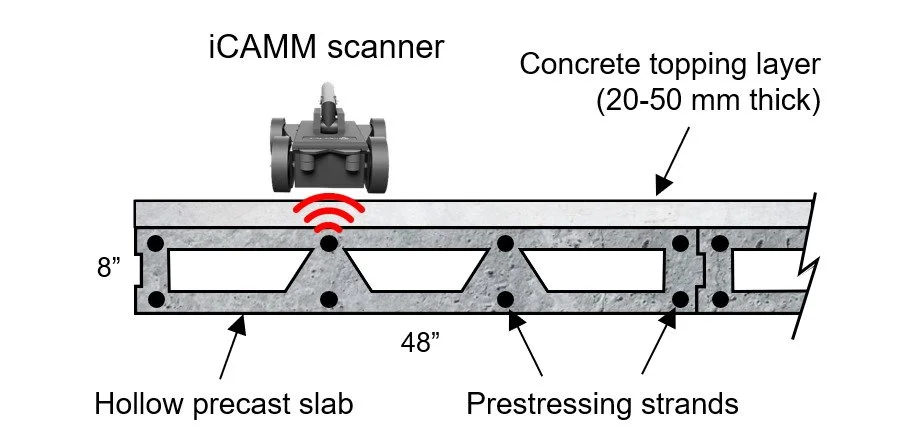Balcony Inspection
Corrosion Mapping of Prestressing Strands in Hollow Precast Balcony Slabs
In this project, InspecTerra's iCAMM scanning tool was used to assess the condition of selected precast concrete balconies in a condominium complex. The apartment buildings were constructed in the late 1970's, with some of the balconies showing signs of degradation. The external balconies consisted of multiple 48" wide by 8" thick hollow precast concrete slabs that cantilever beyond the face of the building by 5 feet. The slabs contained trapezoidal shaped voids, while the reinforcement consisted of standard 7/16" diameter 7 wire prestressing strands.
One of the apartment buildings at the condominium complex.
The interesting aspect of this project was that the top side of each balcony was covered with a 20-50 mm thick non-reinforced and non-waterproofed concrete topping layer. The presence of coatings and other material layers poses a significant challenge for conventional NDT methods (e.g., the half-cell test, acoustic methods, etc.), as the interface between the layers disrupts and interferes with the signal acquisition. However, because the operation of the passive iCAMM inspection tool is not impacted by surface coverings, the condition of each prestressing strand in the precast slabs was assessed directly through the concrete topping layer.
Each balcony was inspected in less than 1 hour by the iCAMM tool. The collected magnetic data were used to quantitatively map out the degree of section loss of the prestressing strands due to corrosion. The results were well correlated with visual observations on the concrete surface, with more significant corrosion taking place in areas with significant cracking in the concrete topping layer. Based on the assessment of the iCAMM data, it was also possible to determine that there was no evidence of loss of prestress in any of the inspected prestressing strands.
This project clearly demonstrated the benefits of the novel iCAMM inspection tool, which provides quantitative information about the structure's condition quickly and effectively without the need for any surface preparation or direct access to the embedded reinforcement. The iCAMM tool can also be used in adverse environments (e.g., presence of high humidity and moisture, low (or high) temperatures, presence of salt/chlorides, etc.). The air temperature during this project was between 0 and +2 degrees Celsius, with occasional snow flurries.
Download a summary of this project:




